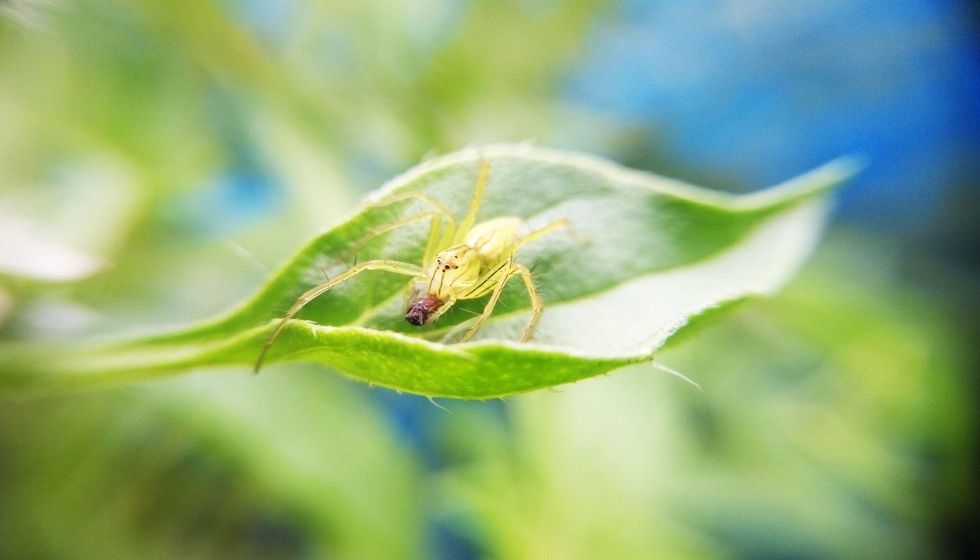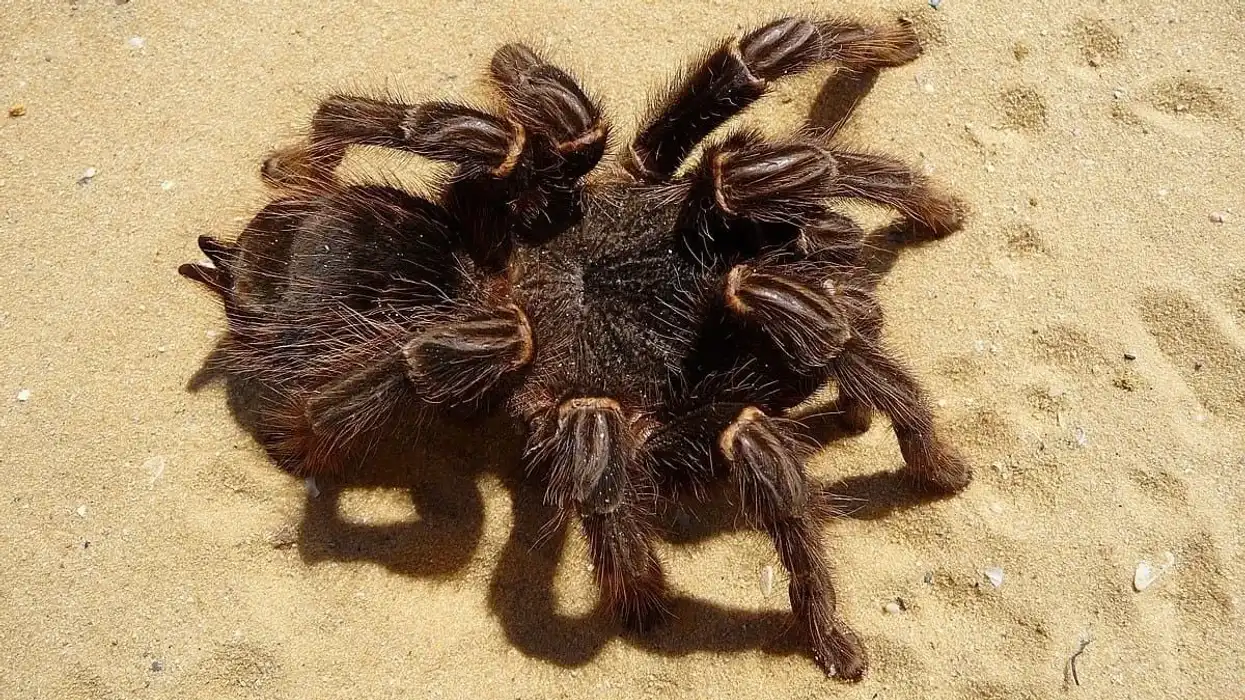The green crab sider (Misumessus oblongus) is a crab spider in the family Thomisidae in order Araneae. The family has a total of 175 genera and more than 2,100 species.
The distribution range of green crab spiders is from the United States to Canada. Various habitats of this spider include woodlands, meadows, grasslands, the backyard of the house, and many more. Females of green crab spider species are twice than the males.
Like other spiders, the flower spider does not for its web to catch its prey. Both sexes spin silk for numerous other purposes. Females use the silk to form sac for their eggs, while males cover the females with their silks when latter incubate their eggs.
They have broad, flattened bodies and four pairs of legs. The frontal legs are much larger and more developed than the previous ones. Green crab spiders are diurnal animals, which means they hunt insects during the daytime.
Spiders are quite surprising and interesting to learn about. If you wish to learn more about them, you can check out these crab spider facts and green lynx spider facts.
Green Crab Spider Interesting Facts
What type of animal is a green crab spider?
The green crab spider, Misumessus oblongus is an American spider species that belongs to the family Thomisidae and order Araneae.
What class of animal does a green crab spider belong to?
The green crab spider belongs to class Arachnida and phylum Chordata.
How many green crab spiders are there in the world?
The population size of green crab spiders is unknown but they are numerous in the wild.
Where does a green crab spider live?
The green crab spider, Misumessus oblongus, lives in the United States of America and Canada. The range included six states of America: Georgia, Indiana, Pennsylvania, Alabama, Illinois, and Maryland.
What is a green crab spider's habitat?
The green crab spider, Misumessus oblongus, is usually found outdoors, and in the month of May. This species inhabits woodlands, grasslands, garages, marshes, meadows, tropical rainforests, garages, and shrublands.
It is a roving hunter that climbs up on vegetation, prey on insects on flowers such as, Marigold, Snapdragons, Asters, Daisy, Goldenrods, and Queen Anne’s lace. It is also found in open fields, prairies, and shrubs.
Who do crab spiders live with?
Green crab spiders of the family Thomisidae usually live and hunt alone.
How long does a green crab spider live?
The lifespan of the neon green crab spider species is about one year but it can survive for more years depending upon the type of its habitat.
How do they reproduce?
There is not much information available regarding the reproduction of Misumessus oblongus species. The mating or breeding season of crab spiders usually occurs in the summer season.
Males search for silk threads to find females and install various parcels of sperm on the surface. After that, females find the sperm, collect them with leg-like structures known as palps and fertilize their eggs with the sperms.
Some days later, females lay their fertilized eggs near the web and cover them with the leaves of plants. Females release silk and build cocoon like covering around their eggs and leaves.
They protect their eggs for the next three weeks and do not feed on anything in this incubation period. After hatching, female spiders die out of fatigue.
Juvenile green crab spiders are the smaller version of their parents. They molt several times during the period of growth and development before they become adult size.
What is their conservation status?
The conservation status of crab spiders species is Unknown.
Green Crab Spider Fun Facts
What do green crab spiders look like?
The size of Misumessus oblongus is diminutive. The green crab spider is an animal that has a pale green to silver white body and legs without spots or rings.
Some spiders have pink or red markings. Just like other members of the spider family, its legs are projected outward from the sides.
Therefore, it can move in any direction. The green crab spider, especially the female, has an abdomen of creamy white color, while the color of the male abdomen is brown. The shape of the abdomen is like a diamond or kite.
Most spider crabs live in flowers and seize prey by grasping and biting them. Interestingly, the carapace, abdomen, and legs in the foliage flower spider species have spines.
How cute are they?
Their tiny size and neon green color make Misumessus oblongus or crab spiders look cute. Although, adult humans normally do not like spiders and children easily get scared of them. Apart from this, crab spiders are dangerous animals.
How do they communicate?
The communication methods in the Misumessus oblongus species of the family Thomisidae is not clear. Although, during mating season, males usually follow threads of webs to find females.
How big is a green crab spider?
The green crab spider species is of a small size. While females can reach a length of 9.8 ft (3 m), males usually have a short size than females. They are five times smaller than a ground spider.
How fast can green crab spiders move?
The speed of the green crab spider species family Thomisidae is unknown.
How much does a green crab spider weigh?
The weight of the green crab spider has not been estimated yet.
What are the male and female names of the species?
Male and female green crab spiders have no specific names.
What would you call a baby green crab spider?
The baby green crab spider has no special name.
What do they eat?
Green crab spiders do not build webs to catch their prey, like other spider species. Instead, these spiders hide in the flowers or leaves and wait for their prey. They directly catch the insects, such as moths, mosquitoes, flies, honeybees, and butterflies. The success of their hunt directly depends on their reactions.
Are they poisonous?
Green crab spiders produce venom that is dangerous to their prey, such as mosquitoes and flies but their poison is non harmful to humans.
Would they make a good pet?
They are good pollinators. Therefore, they can become good pets. But it is probably best not to pet this species as it can be a little dangerous and likes its wild environment.
Did you know...
The green crab spider has eight eyes!
Green crab spider bites
Normally, green crab spiders are non aggressive animals. If you find one at home, then gently capture it into a cup and release it outside. However, the chances of their biting are not zero or negative.
They can bite on the body and leave two puncture wounds. The green crab spider bite is non-harmful to humans and it cannot kill you, but it can still be painful. The bite can cause discoloration to the affected area.
What would happen if the green crab spider disappeared?
Like other species of spiders, the flower spiders are an important part of natural food cycles. They are important flower pollinators and pest controllers. If they disappeared, then all our crops will be eaten by the pests.
Here at Kidadl, we have carefully created lots of interesting family friendly animal facts for everyone to discover! For more relatable content, check out these whip spider facts and southern house spider facts pages.
You can even occupy yourself at home by coloring in one of our Green Crab Spider coloring pages.









